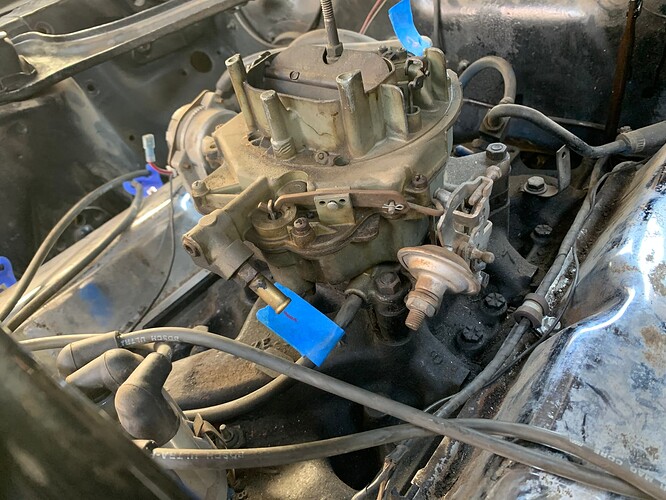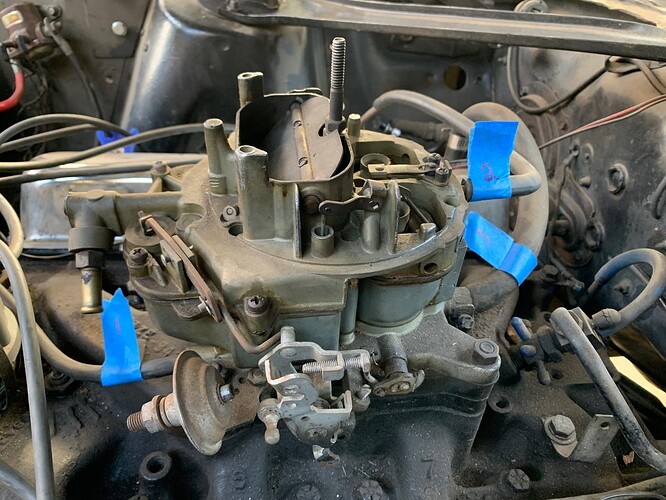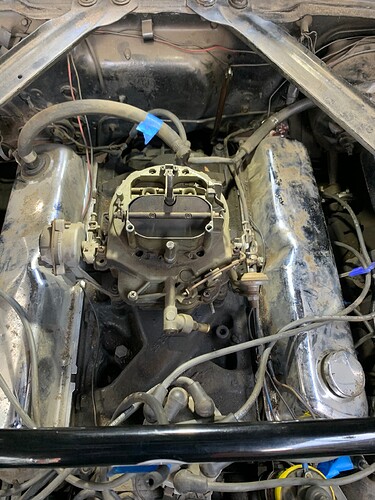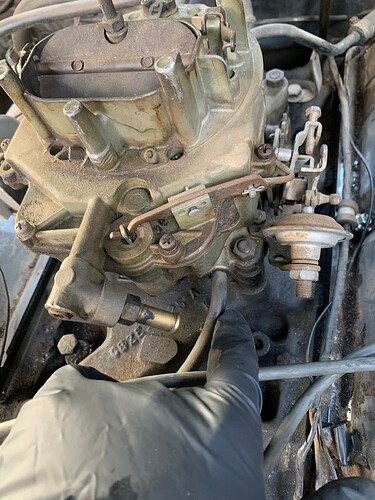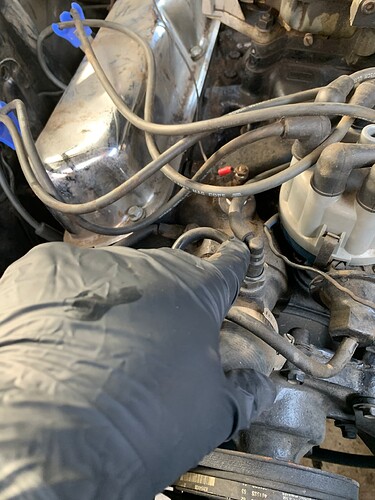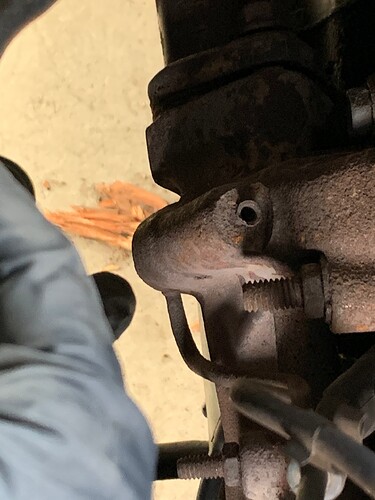Exactly right Royce. The Holley was as plug and play as any carb I’ve ever had. Great driveability on the street.
The Cougar in my signature was bought by me in 1977 with 98,000 miles from the original owner. It was an A code with the stock 289 -4V and that awful carburetor. One of the first things I did was replace the carb with a Holley 0-1850 purchased from Summit. I think it was around $65.00 plus shipping back then. That carburetor stayed on the car until I sold it in 1989 with over 400,000 miles on the clock. Over the years I changed the intake to a variety of aluminum ones, added headers, and an RV cam. Same carb all through the stock engine to modified worked great.
If you are interested in “Why”, the best place to start here is annular boosters. The 4100 carburetor (and its little brother the 2100) are legendary for a couple of reasons, but one of the biggies is annular boosters. Holleys and most Edelbrocks use straight-leg boosters. It is a very inexpensive piece, and its job is to draw fuel out of the bowl to enrich air going by once you’re out of the idle circuit. A straight leg booster usually has a very simple bar going across the middle, where fuel dribbles out into the airstream. When there is a strong amount of air going by, this works fairly well, so at high RPMs it produces a very good droplet size for peak power. However, at very low flow, it does not draw fuel very well, and the droplet size is pretty big as it just dribbles out into the airstream.
Annular boosters have got 6 or more holes, evenly spaced around a ring. They draw fuel even at very low flow, and the fuel that gets mixed with the airstream provides very small droplets. At high rpms, annular boosters produce almost pure vapor instead of droplets.
So why does any of this matter? Because liquid gasoline does not burn. Small droplets and vapor travel just fine through the intake, getting heated up and smashed in the combustion chamber, where they tend to burn very well. Big droplets fall out of the airstream, and puddle along the intake - or just splat against the combustion chamber walls, making carbon deposits, or blowing out your exhaust as partially burnt hydrocarbon emissions.
In practical terms, annular booster carbs like the 4100, Summit M2008VS, and yes, the Edelbrock AVS/2, have superior throttle response (especially at low to midrange RPMs), better economy, and often better peak power than straight or downleg boosters. Because they work well even at low flow, a ‘larger than it should be’ carburetor which would normally hurt performance can work fine on a mild engine. As an example, a 600 CFM Summit M2008VS can be run on a stock 289 (original 2V car) without much fuss. However, putting a 600 CFM Holley on a mild 289 like that will typically result in a loss of throttle response and low-end power, without a lot of work - even if the peak horsepower is still pretty good.
I personally experienced this in a sad way back in the 80s; I had an original 1.08 venturi Autolite 4100 on my '67 Cougar which ran pretty well - but after reading a ton of magazine articles, and being eager to hop up my car’s performance, I dropped a brand new Holley 1850 on top of my engine and threw the old “junky” Autolite away.
I lost about 4 mpg and a whole lot of throttle response.
Often, running a correctly sized carburetor (like the 500 CFM Holley) will overcome a lot of the deficiencies of cheap straight-leg boosters, but even there, going to annular boosters would probably give you a noticeable and positive difference.
While the machining of the new Summit carbs is cheap, as you might expect from an inexpensive Chinesium product, the basic design is so good that rarely matters very much. It’s an incredibly simple, reliable, and well-tested design.
Thanks for detailed and precise information. Very helpful. I am thinking should I get a rebuilt 4100 instead of 4300. If I understand right, there’s two differences between manual and auto trans variants. Auto trans carb has dash pot and kick down lever. If I buy a manual trans carb, it can be converted to auto trans installing those two parts.
I like the idea of using OEM parts so the last 4100 mass production year 1966 auto trans versions C6ZF-B (no smog) or C6ZF-E (Thermactor Equipment) will be just right. I am not sure where my Edelbrock carb is made, but 4100s are positively made in USA. I am happy every time I can replace a repo part with an original piece on my 68.
There is no kickdown linkage on the carburetor in 1967 or 1968 on any Cougar.
While I am a big fan of the 4100, it is difficult to find one with 1.08 venturi in good shape for any kind of reasonable price. The 1.12 can be made to work, but parts availability and information on them are very hard to come by!
The finish on a Summit carb is not as nice, but they are actually easier to tune, and use standard Holley parts like jets.
Grim, back when Pony Carburetors was still in business, I sent them a 1.12" venturi 4100 carburetor for a spreadbore conversion. At the time they were installing bushings to neck down the primary venturis down to 1.00". Not sure who, if anyone is able to perform that conversion anymore.
Was very happy with the results, I really need to get that car out of mothballs.
There’s a lot to it. Not just the diameter of the venturi!
hello grim I’ve got another question for you sir… the summit carbide spoke of has a warning not to install on automatic trans vehicles… what do you know about this? my 68 has an automatic c4
here is what they say in the product notes
" Summit Racing® recommends this part for single carbureted applications only. This carburetor is not intended nor recommended to be used with Ford Automatic Overdrive Vehicles. SEVERE transmission damage may result from improper application use. "
This is a very specific warning about AOD transmissions, and is because the carburetor does not come with a provision for a TV cable to attach to. AOD requires a cable to sense throttle position, and adjust internal pressures. Without it, or with the cable improperly adjusted, an AOD will burn itself up in a few miles. They’re kind of legendary for it.
It will work great with most automatics - just not the Ford AOD, without a little work. =)
ok ill buy it asap… was about to pull the trigger on it and read that not lol
thanks again
got the carburetor would you know where the hoses from the old carb go on the new summit carb… fuel line is obvious but the others are not
I prefer manifold vacuum for my distributor, so I’d cap all of them, and run the distributor to the fitting on the back of the manifold. If you want to use ported vacuum, use the one on your carb that’s low and on the passenger side front of the carb.
Gotta buy some gaskets but here’s where I’m at… so number 3 in the picture would be the only one you would keep ?
The ports on your new carb are a little different. Look at it when you get it out. =)
Keep your existing carb spacer, and keep the PCV hose (3) from the passenger valve cover connected to it.
ok so only keep #3… easy enough… got it in the mail already… looks beautiful… installing it tomorrow morning…
1 gasket
2 stock spacer plate
3 heat spacer that came with summit carb
4 base of carb
Is this the correct order?
What does line 1 belong to? Will I need it in the future? Do I cap the other end?
It’s hard to tell from your pics, but I think 1 and 2 are going to the thermostatic vacuum switch at the front of your engine.
They’re mostly a dumb compromise made for smog engines. At low temps, they run ported vacuum (from the front of your current carb), but as the engine heats up, they switch to manifold vacuum (the hose from the back of your carb). The distributor gets the third hose on that switch.
At idle, ported vacuum has no vacuum going through it, so the distributor is effectively running ‘retarded’, reducing nitrous oxides a little, but dumping extra unburnt fuel into the exhaust and slowing down the engine-driven fan. When the engine is running hot, the switch kicks to manifold vacuum, which speeds up idle a bit, improves combustion in the chambers, cooling off the engine by spinning the fan faster and throwing less flames into the exhaust manifolds.
Here are those two hoses and where they go… so I’ll cap these off and leave the manifold hose(#3)
Also Where do I need gasket seals?
From those pics, I can see that the hoses were hooked up incorrectly. Just disregard them anyway.
The choke stove should not be connected to the rearward fitting on your carburetor. I believe that port is an emission control device, normally connected to manifold vacuum, with a bimetallic strip allowing an air bleed there. Your new carb will not use that port.
If you are trying to use your 4300 (and I don’t know why you would!!) I would just cap that port.
The front port on your carb is ported vacuum. If you intend to use ported vacuum, then connect a vacuum hose directly from that port to your distributor. Otherwise, I would connect a hose from your distributor to the vacuum port on the intake manifold behind your carburetor, and enjoy the benefits of manifold vacuum.
If your new carb has an electric choke, it will not be using the choke stove on your exhaust manifold.
And lastly, what do you mean by gasket seals? Your carb uses a gasket to mate it to the intake?
